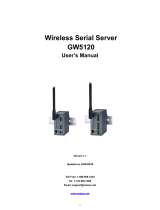
3: Installation of PremierWave XN
PremierWave XN User Guide 20
Table 3-7 WLAN Signal Strength Indicator at 5 GHz
Table 3-8 WLAN Signal Strength Indicator at 2.4 GHz
Table 3-9 WPS Status Indicator
When the signal strength indicator is used to indicate the WPS status, only one amber LED will be
used.
USB 1 GREEN - displays a solid light when a USB device is connected to USB 1 Host port
and is functioning properly.
OFF- when no USB device is connected to USB 1 Host port.
USB 2
GREEN - displays a solid light when a USB device is connected to USB 2 Host port
and is functioning properly.
OFF- when no USB device is connected to USB 2 Host port.
Fault/Diagnostic See Table 3-10 for diagnostic indications.
Signal Strength
LEDs
Indicates WLAN signal strength when connection is established. During WPS
negotiation and connection establishment, it reports status of WPS transaction.
When indicating the WLAN signal strength, see Table 3-7 for signal strength
information for connections in 5 GHz band or Table 3-8 for signal strength
information for connections in 2.4 GHz band.
For WPS status indications, see Table 3-9.
Signal Strength Color & Number of LED Signal Bars
Greater than or equal to -60 dBm 5 Green
Greater than or equal to -62 dBm and less than -60 dBm 4 Green
Greater than or equal to -65 dBm and less than -62 dBm 3 Green
Greater than or equal to -68 dBm and less than -65 dBm 2 Amber
Greater than or equal to -70 dBm and less than -68 dBm 1 Amber
Less than -70 dBm All Off
Signal Strength Color & Number of LED Signal Bars
Greater than or equal to -60 dBm 5 Green
Greater than or equal to -67 dBm and less than -60 dBm 4 Green
Greater than or equal to -73 dBm and less than -67 dBm 3 Green
Greater than or equal to -98 dBm and less than -73 dBm 2 Amber
Greater than or equal to -110 dBm and less than -98 dBm 1 Amber
Less than -110 dBm All Off
WPS Status Blink Pattern
WPS is enabled and on Short, continuous
WPS has a profile error Long, long, long, short, short, 2 seconds off,
continuous
WPS has a timeout error Long, long, long, short, short, short, short, 2 seconds
off, continuous
LED (continued) Description























